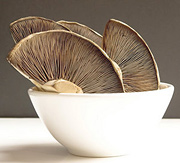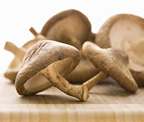Wild About Mushrooms
By Zhenya K. Wine
My childhood memories of my life in Russia include many summer and fall trips with family and friends to gather mushrooms, herbs and berries. It was a family tradition and something we all looked forward to doing together. However, there is an art to this foraging. It's important to know what to pick and how to preserve what you can't use immediately. But when the gathering is complete, we are blessed with the one of the most healing and delicious foods that nature produces. Approximately 1.5 million fungi are found in the world - molds, fermenting bacteria, and other spores fall into this category - only 70,000 (5 percent) of this large species have been studied. Here I will outline the medicinal properties of four edible mushrooms: porcini, chanterelle, crimini and portabella. Some of these might grow in your area, but before eating any mushrooms you pick, I would recommend consulting your doctor/nutritionist or local mushroom club, since some mushrooms are quite poisonous. The mushrooms discussed here I purchase at a local store in a dried or fresh form and have been certified as ready for consumption. Let's begin with two European mushrooms - . The king of mushrooms is known as (Latin) and is called in France, in Germany, and in Italy. In U.S. grocery stores, you most likely will see them referred to as porcini and they can be purchased either fresh or dried. When examining the porcini, you will see a mushroom with a large brown cap, fat stem, and a heavy and heavenly smell.
 When cutting this mushroom, observe the very white and slightly porous flesh. Although very delicious when cooked, this mushroom possesses incredible healing properties. According to Russian research done on its medicinal attributes, porcini is used as a medicinal remedy in the treatment of tuberculosis, general weakness, and to improve metabolic functions. Some of the Russian folk medicine writings that survived from the 1600s talk about the use of porcini extractions in treatments of hard-to-treat skin ulcerations and frost bite. An alkaloid found in it is used to treat cardiac angina. Beta-glucan, which is found in most mushrooms and is present in high concentrations in porcini, is instrumental in cardiovascular health and provides many other health benefits. In ancient times, it was believed that by eating porcini, you might be able to prevent intestinal dysfunctions.This has been proven true by research. Scientists have found oligosaccharide (a simple sugar) in cooked and raw porcini. The undigested parts of this sugar promote probiotic activity in the colon by stimulating growth of healthy bacteria.
When cutting this mushroom, observe the very white and slightly porous flesh. Although very delicious when cooked, this mushroom possesses incredible healing properties. According to Russian research done on its medicinal attributes, porcini is used as a medicinal remedy in the treatment of tuberculosis, general weakness, and to improve metabolic functions. Some of the Russian folk medicine writings that survived from the 1600s talk about the use of porcini extractions in treatments of hard-to-treat skin ulcerations and frost bite. An alkaloid found in it is used to treat cardiac angina. Beta-glucan, which is found in most mushrooms and is present in high concentrations in porcini, is instrumental in cardiovascular health and provides many other health benefits. In ancient times, it was believed that by eating porcini, you might be able to prevent intestinal dysfunctions.This has been proven true by research. Scientists have found oligosaccharide (a simple sugar) in cooked and raw porcini. The undigested parts of this sugar promote probiotic activity in the colon by stimulating growth of healthy bacteria. The leading indication of the porcini mushroom is believed to be its influence in treatment and prevention of cancer. The Bohemian forests (not to be confused with The Black Forest) of Germany produce a specific variety of this mushroom in areas where it grows in a symbiotic relationship with white pine. After an in-depth cultural investigation, it was found that the population of this region has one of the lowest cancer occurrences, which was attributed to the Boletus mushroom found in the population's diet. The understanding is that the impressive presence of selenium, beta-glucan and L- ergothioneine in this mushroom is the reason for its anti-tumor activity. This mushroom possesses the highest number of amino acids when compared to other mushrooms. Such essential and non-essential amino acids as L-leucine, tyrosine, arginine and glutamine are present in porcini at a rate of 14 percent to 37 percent. Potassium, calcium and phosphorus are present in the porcini at significant rates as well. Porcini also is one of the few mushrooms rich in vitamin D and other vitamins such as B1, B2 and C, as well as carotenoids that convert to vitamin A. Another quite easily obtainable mushroom is called chanterelle. The most interesting point about this mushroom is that it only grows in the wild, so its availability in fresh form is limited. This mushroom is best preserved in a frozen form because drying or pickling it destroys some of the abundant vitamins found within. Of all mushrooms, chanterelle has the highest amount of vitamin B (B1, B2). In fact, the only foods that contain higher B content are liver and yeast. Don't despair if you do not get this mushroom fresh or fresh frozen, because the dry form of chanterelle, although lower in vitamin B content, still is a great source of various vitamins and amino acids. Like all mushrooms, chanterelles are used to enhance the immune system function. Although you might have to hunt in the specialty stores for porcini and chanterelle mushrooms, crimini and portabella mushrooms are very easily obtainable in any grocery store. Although they may lack the fragrance and taste of the mushrooms grown in the wild, they still are quite medicinal when added to any diet.
 Crimini, or button mushrooms, come in white or brown caps and both varieties are quite rich in selenium and beta glucan. Selenium and beta glucan help to activate the immune system, which works to fight infection, bacterial and viral presence and mutation of cells in the body. A Penn State University study found that portabella and crimini mushrooms have a high amount of L- ergothioneine, an exceptionally powerful antioxidant. Besides its ability to neutralize free radicals, L- ergothioneine increases activity of enzymes responsible for the antioxidant activity. L- ergothioneine also participates in protecting cells from mutating reproduction (i.e., cancer cell growth) and aids in liver detoxification. Other effects of this agent include protection of the body from UV and radiation damage as well as protection of the mitochondria, which are cellular power producers. The most important finding belongs to Dr. Dirk Grundemann of the University of Cologne in Cologne, Germany. He confirmed that L-ergothioneine is effective in treating chronic inflammatory disease (CID), which makes mushrooms a dietary must for arthritis and other CID sufferers.
Crimini, or button mushrooms, come in white or brown caps and both varieties are quite rich in selenium and beta glucan. Selenium and beta glucan help to activate the immune system, which works to fight infection, bacterial and viral presence and mutation of cells in the body. A Penn State University study found that portabella and crimini mushrooms have a high amount of L- ergothioneine, an exceptionally powerful antioxidant. Besides its ability to neutralize free radicals, L- ergothioneine increases activity of enzymes responsible for the antioxidant activity. L- ergothioneine also participates in protecting cells from mutating reproduction (i.e., cancer cell growth) and aids in liver detoxification. Other effects of this agent include protection of the body from UV and radiation damage as well as protection of the mitochondria, which are cellular power producers. The most important finding belongs to Dr. Dirk Grundemann of the University of Cologne in Cologne, Germany. He confirmed that L-ergothioneine is effective in treating chronic inflammatory disease (CID), which makes mushrooms a dietary must for arthritis and other CID sufferers. All of the mushrooms mentioned contain a weight-reducing agent called chitin, the same carbohydrate found in shell fish, insects, octopi and squid. It's the primary component of the cell walls of all the mushrooms and is considered to be more cellulose (or fiber) than regular carbohydrate. Scientists at the University of Illinois at Urbana-Champaign found that chitin was present in the highest levels in uncooked portabella. Since chitin is used for production of surgical thread due to its ability to aid in scar tissue regeneration, ingestion of mushrooms containing chitin during postsurgical period is highly recommended. The only thing to keep in mind when looking into chitin content in mushrooms is its easy decomposition during heating or cooking. So for those of you wanting to get a plant form of chitin, rather than that which is derived from shell fish, pick the young (smaller in cap size) portabella and add it raw to your salad. Because of their powerful effects, mushrooms should not be included in the diet of young children (I am speaking of both cooked and raw mushrooms). As always, be cautious if you are a novice mushroom eater because this group of plants can produce severe allergies. But for those of you who have just forgotten about this tasty, healthy creation, enjoy mushrooms as often as you can. The easiest way to prepare mushrooms is by simply sautéing them in a small amount of butter, vegetable or olive oil. Adding onion after the water has cooked out of the mushrooms will maximize its flavor. This can be a base for mushroom barley soup or just a sauce for boiled buckwheat or a potato - just add a few tablespoons of sour cream after the mushroom/onion combination has cooked down into a soft state. Whatever way you choose to prepare mushrooms, eating them will most definitely contribute to your health and well-being.
Zhenya K. Wine has practiced and taught Russian medical and sports massage and physiotherapy for 31 years, and runs the Kurashova Institute in Rock Island, Ill.
Page printed from:
http://www.toyourhealth.com/mpacms/tyh/article.php?id=1021&no_paginate=true&no_b=true
|

